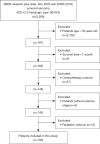Epidemiology, incidence, and survival of synovial sarcoma of children: a SEER database analysis
- PMID: 39144434
- PMCID: PMC11319996
- DOI: 10.21037/tp-24-59
Epidemiology, incidence, and survival of synovial sarcoma of children: a SEER database analysis
Abstract
Background: Roughly 5% to 10% of soft tissue sarcomas fall under the category of synovial sarcomas (SSs), a rare and malignant tumor originating from soft tissues with unclear differentiation, primarily affecting teenagers and young adults. The goal of this study was to assess the latest survival rates for SS of children and the risk factors affecting survival using the Surveillance, Epidemiology and End Results (SEER) database.
Methods: Age, sex, race, SEER stage, surgery, radiation, chemotherapy, laterality, site of SS, and survival time were collected in the SEER database for survival and prognostic factor analysis. The overall survival curves and cancer special survival were obtained by Kaplan-Meier according to different factors. A multivariate Cox regression model and a predictive nomogram have also been constructed.
Results: A total of 130 patients were enrolled in the study. In the overall survival analysis, age (P=0.01), male (P=0.04), no surgery (P<0.01), chemotherapy (P<0.01), primary tumor site in soft tissue (P=0.02), and in distant of SEER stage (P<0.01) were associated with a worse prognosis in children with SS. Multivariate analysis showed that chemotherapy and in distant of SEER stage were independent indicators of unfavorable prognosis. A similar result was released in the specialized cancer survival analysis. A nomogram was used to predict the prognosis of SS in children and a calibration curve was used to validate the nomogram prediction against the actual observed survival outcomes.
Conclusions: In summary, chemotherapy, and worse SEER stage were associated with poorer overall and cancer special survivals. Nomogram was able to predict the probability of 1-, 5- and 10-year overall survivals and showed good consistency with the actual observed outcomes.
Keywords: Surveillance, Epidemiology and End Results (SEER); Synovial sarcoma (SS); children; survival.
2024 Translational Pediatrics. All rights reserved.
Conflict of interest statement
Conflicts of Interest: All authors have completed the ICMJE uniform disclosure form (available at https://tp.amegroups.com/article/view/10.21037/tp-24-59/coif). The authors have no conflicts of interest to declare.
Figures




References
LinkOut - more resources
Full Text Sources
